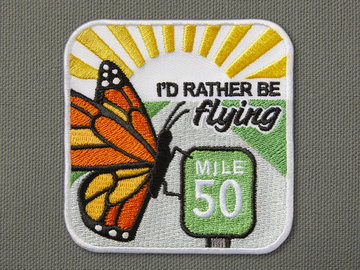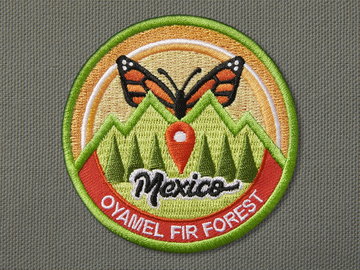A monarch butterfly road trip
Learn more about the monarch butterfly’s annual migration
There are few things more iconic than the great road trip. And each year, monarch butterflies take one of the most ambitious ones out there as they migrate south before winter.
When the days get shorter and the temperatures drop, monarchs begin their search for a safe place. Each fall, monarch butterflies leave their summer breeding grounds in northeastern U.S. and Canada to travel nearly 3,000 miles to reach the overwintering grounds in southwestern Mexico.
It’s important to know directions on a trip, but there is no map available for the monarch butterfly. They use their eyes to monitor the position of the sun in the sky, but the sun’s position is not enough to determine direction. Each butterfly must also combine that information with the time of day.
Monarchs possess an internal clock, which is centered in their antennae, and the information travels via neurons to the brain. This also helps them stay on course as they navigate south.
We see monarchs when they are flying close to the ground, but this accounts for only a small part of their migration. At progressively higher altitudes, wind speed increases rapidly. When winds are going in the right direction, it benefits monarchs to drift upward. And if thermal winds are strong, they may rise until we can’t see them.
Pilots have observed monarchs as high as 10,000 feet during their trip north, and monarchs may have even been picked up by NEXRAD radar. The opposite is true when it comes to strong southern winds during the southern migration. If winds are too strong and going in the wrong direction, monarchs will fly very low or won’t fly at all.
At high altitudes, monarchs sometimes fly up to 30 miles per hour. However, many butterflies stick to the more reasonable five miles per hour or a little faster. Safety first!
They travel about 50 miles per day, and if conditions are good, they can cover 100 miles. It can take up to two months to complete their journey to the oyamel fir forests. According to the USDA Forest Service, the farthest ranging monarch butterfly recorded traveled 265 miles in one day.
Along their trip south, monarch butterflies often begin to reach Mexico during Dia de los Muertos, the celebration honoring deceased loved ones. Locals have long celebrated the monarchs return in memory of their deceased relatives.
This ancient lore goes back to Aztec tradition. It was believed the souls of the departed will return as hummingbirds and butterflies. Spanning centuries, ancient lore and the monarchs’ annual return has been linked.
The monarchs that fly south all this way are known as the super generation. They are slightly different from their parents, grandparents and great grandparents, who only live up to four weeks.
The super generation lives longer, 8 months, and travel 10 times further. They conserve more energy through storing fat in both the caterpillar and butterfly life stages. They also tend not to be reproductively active during the migration, saving energy by not producing eggs.
Once the super generation arrives in Mexico, the monarch butterflies spend the winter in the oyamel fir forests, which are only found in 12 high-altitude mountaintops in Mexico’s Transverse Neovolcanic Belt. During the dry season from November to May, the oyamels need more moisture than what is provided by precipitation. These high altitude forests have cloud cover that forms around the mountain tops, providing that much-needed moisture.
The monarchs seek out these high mountain environments for the same reason the oyamels grow there, it’s cool and fairly moist at high elevations but it doesn’t freeze. These conditions allow the monarchs to slow their metabolism, conserving their bodies’ reserves until spring when nectar sources are again available.
Monarch butterflies in their overwintering sites do not begin reproducing until about mid-February, which is called suspended reproduction, or reproductive diapause. During diapause, the juvenile hormone is absent, which is a necessary hormone for reproduction.
Eventually warmer and longer days will awaken the monarch butterflies to eat and reproduce. Most of the mating will happen at the overwintering sites before leaving the clusters and heading northward.
Female monarchs find milkweed on their journey north through a combination of visual and chemical cues. When they land on a plant that might be milkweed, they drum their forelegs on the surface to release chemicals.
Then, sensors on all six of their legs and antennae, called chemoreceptors, can tell the butterfly whether the plant is indeed milkweed, and if so, whether this is a high quality plant worth laying an egg upon.
Monarch caterpillars store milkweed chemicals called cardenolides while they eat the plant. The caterpillars have adapted enzymes that are almost entirely immune to the cardenolides’ toxic effects.
The toxicity and taste of the cardenolides act as a defense from predators, which in most animals disable a vital potassium pump enzyme if they are absorbed into the blood. The butterfly’s bright colors also serve as a warning, saying stop, don’t eat!
Mature monarch caterpillars will eat a milkweed leaf in about four minutes, gaining nearly 2,700 times their original weight and increasing their size 200 to 300 times in just two weeks.
As their growth rate is significant, the skin becomes rigid and tight. To accommodate for their rapid growth, the caterpillars will shed their cuticle, or exoskeleton, four times before heading into the chrysalis stage.
The final molt of monarch caterpillars hardens into the chrysalis, which protects them during the 10–14 days it takes to transform into an adult butterfly.
When they emerge from the chrysalis, they will have much better eyesight and reproductive organs. Their new wings will be damp and wrinkled, so fluids will start pumping into their wings to dry them out and eventually unfold.
Monarchs spend the summer spread out across huge swaths of the northern U.S. and southern Canada, where summer breeding helps push the population back into the hundreds of millions.
They will remain up north until autumn, where the super generation is born. As soon as the daylight hours shorten, temperatures fall and their flowering nectar sources go dormant, their journey south begins again.
About BASF’s Agricultural Solutions division
With a rapidly growing population, the world is increasingly dependent on our ability to develop and maintain sustainable agriculture and healthy environments. Working with farmers, agricultural professionals, pest management experts and others, it is our role to help make this possible. That’s why we invest in a strong R&D pipeline and broad portfolio, including seeds and traits, chemical and biological crop protection, soil management, plant health, pest control and digital farming. With expert teams in the lab, field, office and in production, we connect innovative thinking and down-to-earth action to create real world ideas that work – for farmers, society and the planet. In 2018, our division generated sales of €6.2 billion. For more information, please visit www.agriculture.basf.com or any of our social media channels.
About BASF
BASF Corporation, headquartered in Florham Park, New Jersey, is the North American affiliate of BASF SE, Ludwigshafen, Germany. BASF has more than 20,000 employees in North America and had sales of $19.7 billion in 2018. For more information about BASF’s North American operations, visit www.basf.com.
At BASF, we create chemistry for a sustainable future. We combine economic success with environmental protection and social responsibility. The approximately 122,000 employees in the BASF Group work on contributing to the success of our customers in nearly all sectors and almost every country in the world. Our portfolio is organized into six segments: Chemicals, Materials, Industrial Solutions, Surface Technologies, Nutrition & Care and Agricultural Solutions. BASF generated sales of around €63 billion in 2018. BASF shares are traded on the stock exchange in Frankfurt (BAS) and as American Depositary Receipts (BASFY) in the U.S. Further information at www.basf.com.













